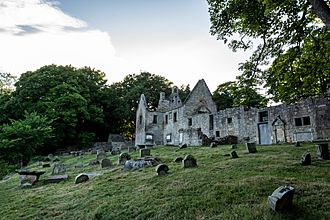St Bridget's Kirk facts for kids
Quick facts for kids St. Bridget's Kirk |
|
|---|---|

Ruins of St. Bridget's Kirk
|
|
| General information | |
| Town or city | Dalgety Bay, Fife |
| Country | Scotland |
| Official name | St Bridget's Kirk |
| Type | Ecclesiastical: burial avile/vault; burial ground, cemetery, graveyard; church |
| Designated | 31 December 1936 |
| Reference no. | SM90266 |
St. Bridget's Kirk is a very old ruined church near Dalgety Bay in Fife, Scotland. It's like a shell of a building that has been around since at least 1178! It was changed a bit in the 1600s for a different type of Christian worship, but it has been a ruin since the 1800s.
Contents
The History of St. Bridget's Kirk
The Church's Ancient Roots
St. Bridget's Kirk was once part of a village called Dalgety. Today, the ruins are the only part of that old village still standing. We know the church existed by March 11, 1178. That's when Pope Alexander III officially called for the "Church at Dalgetty" to be founded.
Later, the church became connected to a nearby monastery called Inchcolm Abbey. In 1244, a bishop named David de Bernham from St. Andrews officially blessed the church.
Changes and Challenges
In 1641, a new minister named Rev. Andrew Donaldson started working at St. Bridget's. He helped build a school for the community. During this time, there were disagreements about how churches should be run. King Charles I wanted churches to follow a system called Episcopalianism, which had bishops. Rev. Donaldson believed in Presbyterianism, which had a different structure.
Because he disagreed with the King's ideas, Rev. Donaldson was removed from his job. He refused to leave and was eventually forced out by soldiers sent by Archbishop James Sharp. Rev. Donaldson was even put in prison. However, because the political situation kept changing, he was later allowed to return to St. Bridget's and continue his work.
Becoming a Ruin
St. Bridget's Kirk was changed quite a lot in the 1600s. But by the early 1800s, the building was no longer safe. The roof fell off in 1830. After that, a new church was built about half a mile away from the old ruins.
St. Bridget's Kirk Today
Exploring the Ruins
Today, the ruins of St. Bridget's Kirk are looked after by Historic Environment Scotland. You can still access the loft area of the church. A special stone basin called a piscina, which was used for washing holy vessels, is still in good condition.
The church has three separate areas next to the main room:
- The large Dunfermline Aisle is on the west side. It was built around 1610. This aisle contains a burial vault, which is like an underground room, for the Earls of Dunfermline. Alexander Seton, 1st Earl of Dunfermline is buried here.
- The Fordell Aisle is on the north side and was added in the late 1500s.
- The smaller Inglis Aisle is next to the Fordell Aisle and dates from the early 1600s.
The Churchyard and Traditions
An outdoor church service is still held at St. Bridget's Kirk every year in June. Many old, carved gravestones can be seen in the churchyard, some dating back to 1665. There's even a small "keep" built into the churchyard wall. This was a place where church beadles (officials) could guard against "body-snatchers." These were people who would illegally dig up bodies from graves in the past.

